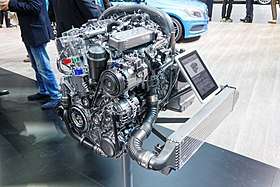Mercedes-Benz OM651 engine
The OM651 is a family of inline-four cylinder automobile diesel engines introduced by Mercedes-Benz in 2008.
 | |
| Overview | |
| Manufacturer | Mercedes-Benz |
| Production | 2008–present |
| Layout | |
| Configuration | Inline 4[1] |
| Displacement | 1796 cc (1.8 liter engine) 2143 cc (2.2 liter engine) |
| Cylinder bore | 83 mm (3.27 in) |
| Piston stroke | 83 mm (3.27 in) 99 mm (3.9 in) |
| Block material | Cast iron [2] |
| Head material | Aluminium alloy |
| Valvetrain | DOHC |
| Compression ratio | 16.2:1 |
| Combustion | |
| Turbocharger | Single turbo / twin-turbo |
| Fuel system | Common rail |
| Fuel type | Diesel |
| Cooling system | Water cooled |
| Output | |
| Power output | 100–150 kW (134–201 hp) |
| Chronology | |
| Predecessor | Mercedes-Benz OM646 engine |
| Successor | Mercedes-Benz OM654 engine |
Design
The main goal was to create a common engine design that maximized the parts commonality between the engines manufactured by parent company, Daimler.
One requirement of the design was the ability of the engine to be mounted both longitudinally and transversely. Improved fuel efficiency and compliance with Euro 5 emission standards were also design objectives, by 2010 being updated to the Euro 6 standard; four piezo-electric injectors fed with very high pressure fuel from a common rail inject fuel directly into the combustion chambers to improve combustion compared to previous Mercedes Diesel engines and recirculated exhaust gas reduces the oxygen in the cylinders to "starve" any reactions that would produce NO(x).
Although all engines have the same 2.1 L (2,143 cc) swept volume, engines with various power outputs are produced ranging from 109 PS (80 kW) (badged x180) 136 PS (100 kW) (badged x200) 170 PS (125 kW) (badged x220) to 204 PS (150 kW) (badged x250). The 170 PS (125 kW) and 204 PS (150 kW) versions employ a bi-turbo charging setup with a small, high pressure turbo providing quick boost at low RPM and a large, lower pressure turbo providing increased performance at higher RPM. The 100 kW (134 hp) lower output version has only a single turbocharger.
In the summer of 2017 the engine, together with OM642, is under investigation whether for the engine operated in a laboratory emissions testing, a different amount of diesel exhaust fluid is used illegally, other than in real world operating scenarios.[3]
References
- http://www.caranddriver.com/features/mercedes-engine-transplant-modern-diesel-in-a-1992-190e-26
- http://www.emercedesbenz.com/Apr08/11_001100_Mercedes_Debuts_New_Generation_Of_Four_Cylinder_Diesel_Engines.html
- Abgas-Skandal: KBA findet angeblich deutliche Hinweise auf illegale Abschalteinrichtungen in Mercedes-Dieselautos, heise, 2017-07-14 (in German).